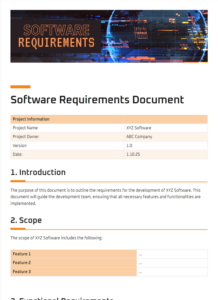Developing a clear and comprehensive system requirement document is crucial for the success of any software or hardware project. A system requirement document template provides a structured framework to gather, analyze, and document the functional and non-functional requirements of a system.
It serves as a valuable communication tool between stakeholders, ensuring that all parties involved in the project have a shared understanding of the system’s purpose, capabilities, and limitations. Here’s a detailed guide to help you understand and utilize a system requirement document template effectively.
Sections of a System Requirement Document Template
A typical system requirement document template consists of several key sections that collectively capture the project’s essential information. These sections include:
1. Introduction: Provides an overview of the project, its purpose, and the intended audience for the document.
2. Scope: Defines the boundaries of the system and identifies the specific requirements that will be addressed.
3. Functional Requirements: Outlines the specific functionalities that the system must perform, including both user-facing and system-level features.
4. Non-Functional Requirements: Describes the overall qualities and characteristics of the system, such as performance, security, usability, and reliability.
5. System Interfaces: Documents the interactions between the system and its external environment, including hardware, software, and users.
6. Other Sections: May include sections for glossary, references, and appendices to provide additional context and support.
Benefits of Using a System Requirement Document Template
Utilizing a system requirement document template offers numerous benefits for project teams:
– Consistency: Ensures that all requirements are captured and documented in a standardized format, making it easier to compare, analyze, and track progress.
– Completeness: Provides a comprehensive view of the system’s requirements, reducing the risk of missing or overlooked functionalities.
– Communication: Facilitates clear and concise communication among stakeholders, reducing misunderstandings and ensuring that everyone has a shared understanding of the project goals.
– Traceability: Allows the project team to easily track and trace requirements throughout the development lifecycle, making it easier to manage changes and ensure that all requirements are met.
– Prioritization: Helps prioritize requirements based on their importance and impact, enabling the project team to focus on the most critical aspects of the system.
– Baseline: Establishes a baseline against which the system’s actual performance can be measured, providing a reference point for evaluating progress and identifying areas for improvement.
Conclusion
A system requirement document template is an indispensable tool for project teams embarking on the development of software or hardware systems. By using a template, organizations can effectively capture, analyze, and document the requirements of their systems, ensuring that all stakeholders have a shared understanding of the project’s goals. This comprehensive documentation facilitates effective communication, improves traceability, and provides a baseline for evaluating system performance. Embracing a system requirement document template is a crucial step towards delivering successful and high-quality IT solutions.
Remember, while a template provides a structured framework, it’s essential to customize it to fit the specific needs of your project. By tailoring the template to your project’s unique requirements, you can maximize its benefits and ensure the success of your system development endeavor.

